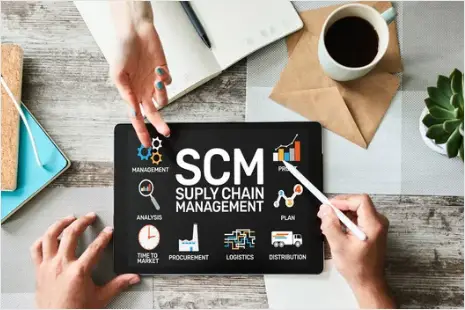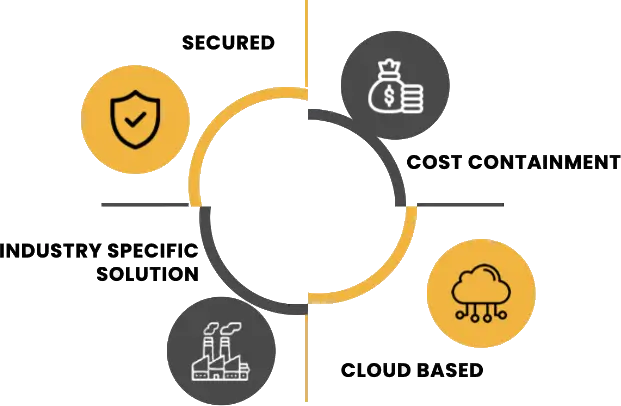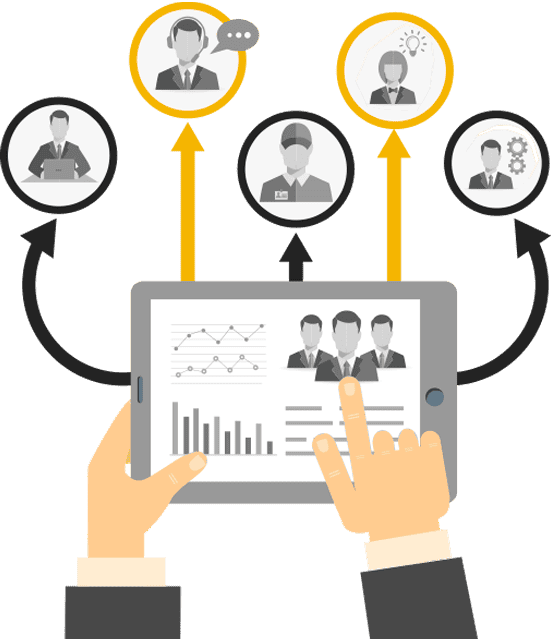
Enterprise Resource Planning or ERP software for small businesses is a software suite that integrates all business functions and processes into a single SaaS tool. It uses a single database for all business data and acts as the central business management tool for your small business to automate and streamline its operations, and enjoy enhanced productivity.
ERP for small businesses is highly advantageous as it not only integrates all departments such as finance, sales, procurement, production, supply chain, inventory, and customer relationships into a single system but also enables them to work together by sharing real-time data. This skyrockets your operational efficiency and helps you make data-driven decisions for your business growth. When you implement ERP software for small businesses, you are able to meet the changing market demands and stay competitive even in challenging times.
Proximo, the best ERP for small businesses has been developed by a knowledgeable and skilled team that has more than two decades of industry experience. We’ve worked with thousands of clients from across all industries to develop Proximo to be the perfect solution to all your operational challenges and bottlenecks. It is the best cloud ERP system and is platform-independent and license-free as well.
If you’re a small business and have been struggling with poor productivity, you can benefit largely from ERP software for small businesses. Your search for the best cloud ERP for small businesses in India ends with Proximo from Autus Cyber Tech. We have no hidden charges and place no restrictions on the number of users. If this sounds exciting and you’re ready to get started, contact us today to claim your free demo!
Enterprise Resource Planning or ERP software for small businesses is a software suite that integrates all business functions and processes into a single SaaS tool. It uses a single database for all business data and acts as the central business management tool for your small business to automate and streamline its operations, and enjoy enhanced productivity.
ERP for small businesses is highly advantageous as it not only integrates all departments such as finance, sales, procurement, production, supply chain, inventory, and customer relationships into a single system but also enables them to work together by sharing real-time data. This skyrockets your operational efficiency and helps you make data-driven decisions for your business growth. When you implement ERP software for small businesses, you are able to meet the changing market demands and stay competitive even in challenging times.
Proximo, the best ERP for small businesses has been developed by a knowledgeable and skilled team that has more than two decades of industry experience. We’ve worked with thousands of clients from across all industries to develop Proximo to be the perfect solution to all your operational challenges and bottlenecks. It is the best cloud ERP system for small businesses and is platform-independent and license-free as well.
If you’re a small business and have been struggling with poor productivity, you can benefit largely from ERP software for small businesses. Your search for the best cloud ERP for small businesses in India ends with Proximo from Autus Cyber Tech. We have no hidden charges and place no restrictions on the number of users. If this sounds exciting and you’re ready to get started, contact us today to claim your free demo!
Also Read: Why Do Small Businesses Need an ERP System?
Top 6 Benefits of ERP Systems for Small and Mid-size Businesses
ERP software for small businesses is a powerful and unified SaaS product that helps you integrate all business processes into a comprehensive software. As it operates by using a central database, all teams can access real-time data and enjoy working together without any hassles. The availability of real-time data with advanced analytics helps stakeholders make strategic decisions for business growth and success.
When you implement ERP for small businesses, you experience enhanced operational efficiency along with ease of data-driven decision-making. ERP software for small businesses also offers ease of business expansion so you can add new processes, products, services, and locations with ease and grow your business to operate in multi-currency as well.
Proximo, the best cloud-based ERP software for small businesses is a transformational tool that gives you a 360-degree view and control over your business from inventory management and procurement to supply chain and financial reporting. It also helps you bring all team members, suppliers, manufacturers, distributors, employees, and stakeholders on a single platform so that you can easily share information, communicate effortlessly, and collaborate conveniently.
Also Read: Top 6 Benefits of ERP Systems for Small and Mid-size Businesses
With Proximo, you not only get customizable dashboards for real-time data insights and analytics but also enjoy automated workflows for effective task management. The biggest advantage is that Proximo can also be easily integrated with other business tools so you have nothing to worry about if you’re using other software along with Proximo.
Proximo has in-depth modules for inventory management, financial management, and customer relationship management as well. Its supply chain management modules work in integration with the sales module and order processing module. There are special modules for procurement and production management for manufacturers to meet customer demands with ease. Proximo is a one-stop solution for ERP software for small businesses.
For a small business like yours, ERP implementation can be a business-changing decision! It is crucial for you to weigh all factors and choose the best ERP for your business. An appropriate ERP can enhance your operational efficiency and lead to greater business gains but a poor choice of ERP can lead to inefficiencies and business downfall!
When you are exploring your ERP options, always focus on your industry recommendations and business goals. As each industry has its own unique business processes and functions, its important for you to check if the ERP you are choosing addresses the specific concerns of your industry and will help you not only overcome your business challenges but also meet your short-term and long-term business goals.
The next most important factor for you to consider is scalability. Always check with your ERP vendor to know if the ERP tool is flexible and will offer you ease of business expansion. As a small business owner, when you choose an ERP software that has the ability to grow with your business, you are future-proofing your ERP investment with the ability to add more users, processes, functions, transactions, and modules.
Needless to say, the most crucial criterion for choosing an ERP for your small business is the user-friendliness of the ERP tool. If the tool has a complex and non-intuitive UI, it can be a big hassle for your team to migrate to the new software and still ensure productivity at work. The idea is to choose an ERP software that has a minimalistic and user-friendly interface so that everyone can enjoy working on the new software!
It will be a big additional benefit if the ERP software you choose can be integrated with your other business tools and systems. With this, you’ll be able to enjoy seamless operations at your small business. Last but not least, always check the vendor’s reputation by reading customer reviews and feedback. Don’t forget to ask your ERP vendor for their after-sales support and services for upgrades and maintenance. When you keep in mind all these factors, you’ll be able to ensure you make the right choice and invest in the best ERP for small businesses.
Proximo isn’t just another ERP tool in the market, it has been designed and developed by expert professionals who have more than two decades of industry experience. We’ve designed Proximo to offer you a 360-degree view of your business from its customizable dashboard so that you can enjoy paperless business management.
The best thing about Proximo is that it is a license-free ERP application for small businesses, you don’t have to pay any additional fee as we haven’t placed any restrictions on the number of users. Proximo is also cloud-based and platform-independent, you neither need any additional hardware nor IT experts at your office, and you can enjoy the ease of business management on the go.
Proximo has been exclusively designed for small business owners like you so that you can enjoy enhanced operational efficiency and ease of business expansion. We are a dedicated team available round-the-clock for anything that you might need our help with.
If you’re ready to switch to cloud ERP for small business in India, we are excited to help you skyrocket your business growth with enhanced productivity, click here to claim your free demo of Proximo today!


Absolutely! ERP is a software suite that is as beneficial for a small-medium business as for large enterprises and organizations. In fact, if you’re a small business and you implement ERP software for small business, you are preparing to scale and expand your business with ease because ERP tools are flexible and offer you ease of growth whether it is in terms of new processes, functions, and users or in terms of new locations and multiple currencies.
As a small business owner, if you’re experiencing poor productivity or finding it challenging to share real-time business data across teams and departments, this can be your sign to migrate to ERP for small businesses. It might seem like a daunting task but once you implement ERP, you’ll enjoy extreme ease of conducting business operations and streamlined business management.
The time to migrate to ERP depends upon multiple factors such as the complexity of your business, whether you need customizations to the ERP tool, the size of your organization, and the specific ERP tool that you’re implementing. The migration process is complex and divided into several phases for ease of implementation. For a rough estimate, it can take anywhere from a few weeks to a few months depending upon your business size you’re your specific requirements
If you run a small business and are looking for the best and smartest way to enhance your efficiency, the answer is ERP software for small businesses. It is a revolutionary tool and can help you automate your processes, streamline workflows, and integrate all functions into a single software tool. It operates on a single database thus facilitating all teams to work together in real-time and acts as the single source of truth for your organization.
The cost of ERP software for small businesses depends upon numerous factors such as the type of ERP software (cloud, on-premise, or hybrid), the number of users, the exact modules, and the level of customizations you need. In general, cloud-based ERP tools are more affordable and can mostly be booked at subscription-based pricing models so that you can pay small investments over a period of time.
Although ERP systems are beneficial for businesses of all sizes, ERP tools are indispensable when the business grows and its operations become complex due to interdependencies. Even if you are a small business but have multiple departments, extensive inventory, and a growing customer base, you can benefit from the implementation of cloud-based ERP software.
Yes! Not all but most ERP tools available in the market offer options for customizations. Once you have a clear outline of your requirements, you can check with the ERP vendors to see if they can accommodate your request for customizations. Always invest in an ERP tool that promises to meet your requirements as that will help you scale and expand with ease.
Yes! Even if you are a small business, enhanced efficiency can help you increase your work productivity so that you get more done in less time. With the implementation of ERP, not only will you enjoy streamlined operations, you’ll also benefit from automation and save time on repetitive and redundant tasks. If you’re already struggling with poor productivity and are looking for a promising solution to your operational worries, consider migrating to ERP for small business.
ERP tools are designed to help with everyday operations and so they have modules for financial management, inventory management, and customer relationship management along with features that support human resource management, sales and order management, and supply chain management. ERP tools offer advanced tools for analytics and reporting and offer support for project management as well.
A manufacturing business does not take care of the production and distribution of goods and services only. Various other moving parts, such as planning, sourcing, warehousing, quality control, and sales, equally contribute to making measurable progress and achieving the desired results. Successful integration of an ERP for small manufacturing company with the manufacturing module enables a business to productively and efficiently carry out otherwise challenging and error-prone activities at every stage. Both small and medium-sized manufacturers can leverage an ERP system and its capabilities to easily:
For an SMB implementing a new ERP system, success depends entirely upon the stakeholders coming together, truly believing in the change that is about to come, and working passionately towards it. The best way to approach the idea of setting up a new ERP system is by identifying your goals and objectives. Once you do that, it can be helpful to explore your options from available ERP vendors and choose the one that not only matches your requirements but also fits your budget. Decide to go ahead with a vendor that feels like a right fit to be your partner for this important business decision. It can be helpful to hire a project manager to take care of the deployment from the start till the end. Prepare your employees for the upcoming changes and seek their help to plan for new workflows and efficient data migration. Plan in advance for change management and assign ample resources for live training of the team. This should be your priority to ensure the business doesn’t suffer from the change.